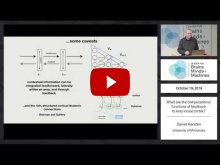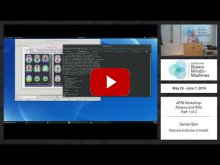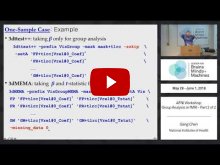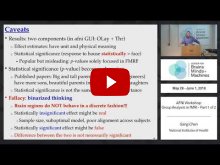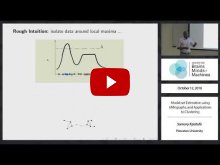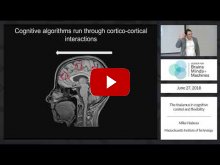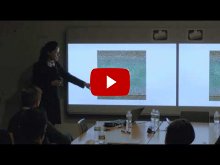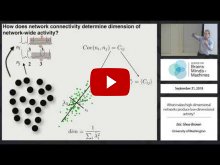
Recorded:
Oct 19, 2018
Uploaded:
October 23, 2018
Part of
All Captioned Videos, Brains, Minds and Machines Seminar Series
Speaker(s):
Prof. Daniel J. Kersten, University of Minnesota
Abstract: The existence of feedforward and feedback neural connections between areas in the primate visual cortical hierarchy is well known. While there is a general consensus for how feedforward connections support the sequential stages of visual...
Recorded:
Oct 9, 2018
Uploaded:
October 16, 2018
CBMM Speaker(s):
Tomaso Poggio
Prof. Tomaso Poggio, Eugene McDermott Professor, Dept. of Brain & Cognitive Sciences, MIT presenting as a keynote speaker for the Fujitsu Laboratories Advanced Technology Symposium (FLATS) 2018.
Lecture slides (PDF)

Recorded:
May 30, 2018
Uploaded:
October 16, 2018
Part of
All Captioned Videos, AFNI Training Bootcamp
Speaker(s):
Daniel Glen, NIMH
Daniel Glen, NIMH
Related documents:
afni10_volreg_talairach.pdf
afni11_roi.pdf
For more information and course materials, please visit the workshop website: http://cbmm.mit.edu.ezproxyberklee.flo.org/afni
We recommend viewing the videos at 1920 x 1080 (...

Recorded:
May 30, 2018
Uploaded:
October 16, 2018
Part of
All Captioned Videos, AFNI Training Bootcamp
Speaker(s):
Gang Chen, NIMH
Gang Chen, NIMH
Related documents:
afni24_GroupAna.pdf
For more information and course materials, please visit the workshop website: http://cbmm.mit.edu.ezproxyberklee.flo.org/afni
We recommend viewing the videos at 1920 x 1080 (Full HD) resolution for...

Recorded:
May 30, 2018
Uploaded:
October 16, 2018
Part of
All Captioned Videos, AFNI Training Bootcamp
Speaker(s):
Gang Chen, NIMH
Gang Chen, NIMH
Related documents:
afni24_GroupAna.pdf
For more information and course materials, please visit the workshop website: http://cbmm.mit.edu.ezproxyberklee.flo.org/afni
We recommend viewing the videos at 1920 x 1080 (Full HD) resolution for...

Recorded:
Oct 12, 2018
Uploaded:
October 12, 2018
Part of
All Captioned Videos, Brains, Minds and Machines Seminar Series
Speaker(s):
Samory Kpotufe
Samory Kpotufe, Princeton University
Estimating the mode or modal-sets (i.e. extrema points or surfaces) of an unknown density from sample is a basic problem in data analysis. Such estimation is relevant to other problems such as clustering, outlier...

Recorded:
Jun 27, 2018
Uploaded:
October 5, 2018
Part of
All Captioned Videos, CBMM Summer Lecture Series
Speaker(s):
Michael Halassa
Mike Halassa, MIT
Recorded:
Dec 1, 2017
Uploaded:
September 27, 2018
Speaker(s):
Prof. Wei Ding, UMass Boston
Prof. Wei Ding, UMass Boston
Abstract:
We will discuss a new algorithm, called Reinforced Network-Based Model for Clustering Sparse Data (REND), for finding unknown groups of similar data objects in sparse and largely non-overlapping feature space...
Recorded:
Sep 21, 2018
Uploaded:
September 25, 2018
Part of
Scientific Interviews
CBMM Speaker(s):
Frederico Azevedo
Speaker(s):
Eric Shea-Brown
On September 21, 2018, CBMM Postdoc Frederico Azevedo took the opportunity to sit down and chat briefly with Prof. Eric Shea-Brown of University of Washington.

Recorded:
Sep 21, 2018
Uploaded:
September 21, 2018
Part of
All Captioned Videos, Brains, Minds and Machines Seminar Series
Speaker(s):
Eric Shea-Brown, University of Washington
Abstract: There is an avalanche of new data on the brain’s activity, revealing the collective dynamics of vast numbers of neurons. In principle, these collective dynamics can be of almost arbitrarily high dimension, with many independent degrees...

